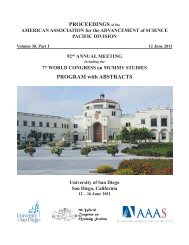Vol 31, Part I - forums.sou.edu ⢠Index page - Southern Oregon ...
Vol 31, Part I - forums.sou.edu ⢠Index page - Southern Oregon ...
Vol 31, Part I - forums.sou.edu ⢠Index page - Southern Oregon ...
You also want an ePaper? Increase the reach of your titles
YUMPU automatically turns print PDFs into web optimized ePapers that Google loves.
ABSTRACTS – Contributed Oral Papers<br />
phenotype. Important epithelial markers include E-cadherin<br />
and α-catenin, which are both cell-cell adhesion proteins that<br />
are down regulated in the presence of inflammatory cytokines.<br />
Mesenchymal markers such as vimentin, fibronectin,<br />
and N-cadherin, which are important for cellular flexibility,<br />
are upregulated in the presence of inflammatory cytokines.<br />
Downregulation of epithelial markers and an upregulation of<br />
mesenchymal markers in conjunction with a change in cellular<br />
morphology is a hallmark for epithelial-mesenchymal<br />
transition (EMT). Once a cell transitions to a mesenchymal<br />
phenotype it is able to metastasize to different locations in<br />
the body. After extravasation, cells arrive at their secondary<br />
location where they will undergo mesenchymal-epithelial<br />
transition (MET), which is a reverse EMT to establish a secondary<br />
tumor. This metastatic process presents major challenges<br />
for the treatment of breast cancer. Targeting inflammatory<br />
cytokines that promote EMT would be beneficial in<br />
preventing metastasis.<br />
Funding provided by NIH R15 NIH R15CA137510; INBRE (NIH/NCRR)<br />
NIH/NCRR P20RR016454 & P20GM103408; Komen KG100513; ACS<br />
RSG-09-276-01-CSM.<br />
127 The Role of Autophagy in the Development and Treatment<br />
of Colon Cancer, TOM DONNDELINGER*<br />
and JOELLA SKYLES (Department of Pathology, St.<br />
Alphonsus Hospital, 1512 12 th Ave Rd, Nampa, ID 83686;<br />
tdonndel@bi-biomics.com).<br />
After implementation of updates to the 120-year-old<br />
biopsy process, newly achieved tissue detail revealed a complex<br />
system of cell recycling in the intestinal crypts of the<br />
colon. This autophagic system involves the migration of<br />
cells up the side of the crypt and, rather than being shed, they<br />
enter autophagocytosis. After entering autophagocytosis, an<br />
autophagic vacuole forms in the cell after which it migrates<br />
through a pore in the basement membrane where the vacuole<br />
can then be enveloped and digested by the macrophage.<br />
A healthy colon is able to dissemble aged cells into amino<br />
acids, peptides, and other materials to be recycled for use in<br />
other cells.<br />
When a signaling error occurs which prevents the<br />
migration of cells through the basement membrane during<br />
autophagy, the cell cannot be effectively recycled but instead<br />
remains at the top of the intestinal crypts where it then continues<br />
the autophagic system. The resumption of autophagy<br />
causes replication of a dysfunctional cell and the development<br />
of an adenomatus polyp with pre-cancerous features<br />
such as an enlarged nucleus...Ultimately, it is the disruption<br />
in the cycle of autophagy that acts as the first step in the<br />
development in colon cancer.<br />
By understanding the role autophagy plays in early stage<br />
colon cancer, new treatment alternatives emerge that involve<br />
the manipulation of this autophagic system. Clinical trials<br />
could then focus on drugs, such as chloroquine, designed<br />
to silence the autophagic signaling in dysfunctional cells in<br />
effort to halt the persistence of select abnormal cells.<br />
128 Quantitative Evaluation of the Inductive Effects of<br />
OSM-Signaling on Breast Cancer Metastasis to Bone,<br />
JIM MOSELHY 1 *, KEN TAWARA 1 , JEFF RED-<br />
SHAW 1 , CELESTE BOLIN 1 , ROBIN ANDERSON 2 ,<br />
and CHERYL L JORCYK 1 ( 1 Department of Biological<br />
Sciences, Boise State University, Boise, ID 83725; 2 Peter<br />
MacCallum Cancer Centre, Melbourne, Victoria, Australia,<br />
8006; jimmoselhy@boisestate.<strong>edu</strong>).<br />
In humans, bone is the most frequent site of metastasis<br />
of breast cancer affecting approximately 75% of patients<br />
with the disease. To better understand the underlying pathological<br />
mechanisms driving breast cancer progression and<br />
metastasis to bone, we have <strong>sou</strong>ght to shed light on the role<br />
of signaling via the IL-6 family pro-inflammatory cytokine,<br />
oncostatin M (OSM) and its receptor (OSMRb). We have<br />
developed a mouse model of bone-metastasizing breast<br />
cancer using the bone-homing murine breast cancer cell<br />
line 4T1.2. Stably transfected 4T1.2 cell lines with knockdown<br />
expression of OSM (4T1.2-OSM) and the respective<br />
vector-transfected control 4T1.2-lacZ were injected into<br />
the 4th mammary fat pad of Balb/c mice. Spines were harvested<br />
from sacrificed animals and genomic DNA extracts<br />
prepared. Real-time quantitative polymerase chain-reaction<br />
(qPCR) was performed on the extracts using primers specific<br />
for neomycin (Neo) as the reporter gene and vimentin (Vim)<br />
as the housekeeping gene. Bone metastasis was assessed by<br />
the relative tumor burden using the comparative (DDCt)<br />
method referenced against genomic DNA derived from the<br />
parental cell lines. To further examine the effects of OSMsignaling<br />
on breast cancer metastasis to bone, a tetracyclineinducible<br />
lentivirus vector was prepared incorporating mouse<br />
OSM (mOSM) gene in order to test the effects of temporal<br />
modulation of OSM levels on bone metastasis. Results from<br />
our experiments will help to establish the impact of tumorderived<br />
OSM on breast cancer metastasis to bone.<br />
Funding for this project is gratefully acknowledged under the following<br />
grants: American Cancer Society: ACS RSG-09-276-01-CSM; Susan G.<br />
Komen for the Cure: KG100513; National Institute for Health Sciences:<br />
NIH/NCRR P20RR016454.<br />
129 A Molecular Mechanism for Metastatic Breast Cancer-Mediated<br />
Bone Destruction, KEN TAWARA* and<br />
CHERYL JORCYK (Department of biological sciences,<br />
Boise State University, 1910 University Drive, Boise, ID<br />
83725; kentawara@boisestate.<strong>edu</strong>, cjorcyk@boisestate.<strong>edu</strong>).<br />
One of the end-stage clinical manifestations of metastatic<br />
breast cancer is osteolytic bone metastases that leads<br />
to pathologic fractures, spinal cord compression, intense<br />
pain, r<strong>edu</strong>ced mobility, and complications associated with<br />
hypercalcemia. In normal bone there is a balance of activity<br />
between the cells that make bone, osteoblasts; and the cells<br />
that degrade bone, osteoclasts. However, metastases to bone<br />
disrupt this balance, which result in uncontrolled osteoclast<br />
activity and bone destruction. Palliative therapies such as<br />
bisphosphonates slow down bone degradation by inhibiting<br />
85








